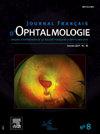Étude de faisabilité d’une téléexpertise d’ophtalmologie en milieu pénitentiaire
IF 1.2
4区 医学
Q3 OPHTHALMOLOGY
引用次数: 0
Abstract
Introduction
L’accès à des soins spécialisés en milieu carcéral est complexe et difficile, particulièrement en ophtalmologie. L’objectif principal de cette étude était de mettre en place une téléexpertise d’ophtalmologie en milieu pénitentiaire pour améliorer le dépistage visuel.
Matériels et méthodes
Il s’agit d’une étude prospective, monocentrique, observationnelle descriptive portant sur tous les patients adressés, présents ou entrants au sein du centre pénitentiaire pour hommes de Rennes. L’examen ophtalmologique a été réalisé grâce des appareils semi-automatisés VX 650 et Eye Refract par le personnel médical et paramédical du centre pénitentiaire non qualifié en ophtalmologie. Le critère de jugement principal était un critère composite de faisabilité, permettant la validation de l’acte de téléexpertise. Celui-ci a évalué l’association d’une pression intraoculaire, d’une rétinographie et d’une lampe à fente, interprétables, associées à une acuité visuelle cohérente.
Résultats
Quatre-vingt seize patients ont participé à l’étude, l’âge moyen était de 41 ans. Le critère de jugement principal a été atteint pour 78 téléexpertises (81,3 %). Soixante-deux téléexpertises (64,6 %) ont été validées sans nécessité d’une consultation en présentiel.
Discussion
Dans notre étude, 34 patients (35,4 %) ont nécessité un deuxième examen en présentiel. Cela s’explique principalement par deux critères de convocation (analyse de l’angle iridocornéen et erreurs de réfraction subjective). Notre protocole de téléexpertise d’ophtalmologie pourra être amélioré par une prise en charge à distance par un professionnel qualifié (ophtalmologiste, orthoptiste) dans certaines situations afin de réduire le nombre de patients convoqués pour une consultation de contrôle.
Introduction
Access to specialty care in prisons is complex and difficult, particularly in ophthalmology. The main goal of this study was to set up an ophthalmology telemedicine service in prisons to improve visual screening.
Materials and methods
This was a prospective, single-center, observational, descriptive study including all patients referred, present, or entering the men's penitentiary in Rennes. The ophthalmological examination was performed using the semi-automated devices, VX 650 and Eye Refract, by the medical and paramedical staff of the penitentiary, who were not qualified in ophthalmology. The primary endpoint was a composite feasibility criterion, allowing validation of the telemedicine encounter. It assessed a combination of interpretable intraocular pressure, fundus photography, slit-lamp examination and consistent visual acuity.
Results
Ninety-six patients participated in the study, with a mean age of 41 years. The primary endpoint was achieved for 78 telemedicine encounters (81.3%). Sixty-two encounters (64.6%) were validated without the need for an in-person consultation.
Discussion
In our study, 34 patients (35.4%) required a second, in-person examination. This was mainly due to two criteria for requesting an in-person visit (iridocorneal angle analysis and subjective refraction errors). Our ophthalmology telemedicine protocol might be improved by remote management by a qualified professional (ophthalmologist, orthoptist) in certain situations to reduce the number of patients requiring a follow-up consultation.
求助全文
约1分钟内获得全文
求助全文
来源期刊
CiteScore
1.10
自引率
8.30%
发文量
317
审稿时长
49 days
期刊介绍:
The Journal français d''ophtalmologie, official publication of the French Society of Ophthalmology, serves the French Speaking Community by publishing excellent research articles, communications of the French Society of Ophthalmology, in-depth reviews, position papers, letters received by the editor and a rich image bank in each issue. The scientific quality is guaranteed through unbiased peer-review, and the journal is member of the Committee of Publication Ethics (COPE). The editors strongly discourage editorial misconduct and in particular if duplicative text from published sources is identified without proper citation, the submission will not be considered for peer review and returned to the authors or immediately rejected.

 求助内容:
求助内容: 应助结果提醒方式:
应助结果提醒方式:


